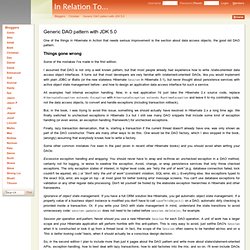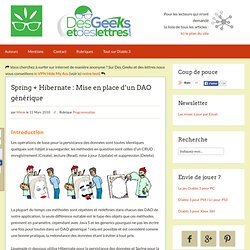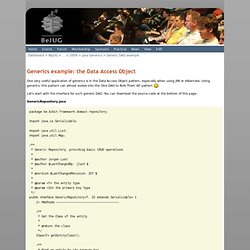

In Relation To... Generic DAO pattern with JDK 5.0. One of the things in Hibernate in Action that needs serious improvement is the section about data access objects, the good old DAO pattern.

Things gone wrong Some of the mistakes I've made in the first edition: I assumed that DAO is not only a well known pattern, but that most people already had experience how to write /state-oriented/ data access object interfaces. It turns out that most developers are very familiar with /statement-oriented/ DAOs, like you would implement with plain JDBC or iBatis (or the new stateless Hibernate Session in Hibernate 3.1), but never thought about persistence services with active object state management before - and how to design an application data access interface for such a service. All examples had internal exception handling. But, in the book, I was trying to avoid this issue, something we should actually have resolved in Hibernate 2.x a long time ago. Excessive exception handling and wrapping. Generic Data Access Objects.
This is a pattern for Data Access Objects with JDK 5.0, from the CaveatEmptor example application.

It is also explained in the book Java Persistence with Hibernate . Two links you might find useful: Sessions and transactions and Open Session in View . This time I based the DAO example on interfaces. Tools like Hibernate already provide database portability, so persistence layer portability shouldn't be a driving motivation for interfaces. However, DAO interfaces make sense in more complex applications, when several persistence services are encapsulate in one persistence layer. The DAO interfaces I use one interface per persistent entity, with a super interface for common CRUD functionality: public interface GenericDAO<T, ID extends Serializable> { T findById(ID id, boolean lock); List<T> findAll(); List<T> findByExample(T exampleInstance); T makePersistent(T entity); void makeTransient(T entity); }
Spring + Hibernate : Mise en place d’un DAO générique. Introduction Les opérations de base pour la persistance des données sont toutes identiques quelques soit l’objet à sauvegarder, les méthodes en question sont celles d’un CRUD : enregistrement (Create), lecture (Read), mise à jour (Update) et suppression (Delete).

La plupart du temps ces méthodes sont répétées et redéfinies dans chacun des DAO de notre application, la seule différence notable est le type des objets que ces méthodes prennent en paramètre, cependant avec Java 5 et les generics pourquoi ne pas les écrire une fois pour toutes dans un DAO générique ? Cela est possible et est considéré comme une bonne pratique, la redondance des données étant à éviter à tout prix. L’exemple ci-dessous utilise Hibernate pour la persistance des données et Spring pour la création des objets et leurs dépendances. Définition. The Generic DAO pattern in Java with Spring 3 and JPA 2.0. One thing that annoys me the most is code duplication.

The DAO layer is the perfect candidate for this kind of situation. Often, developers forget about OOP, polymorphism, and design patterns and just copy and paste code, change the name of the class, and voila, we have a brand “new” BankDao class. I’ll present you how to implement a generic DAO pattern to avoid code duplication and preserve type safety at the same time. Why would you care about type safety and just don’t use EntityManager’s generic methods. Generic DAO example - BeJUG - The Belgian Java User Group. One very useful application of generics is in the Data Access Object pattern, especially when using JPA or Hibernate.

Using generics, this pattern can almost evolve into the 'One DAO to Rule Them All' pattern Let's start with the interface for such generic DAO. You can download the source code at the bottom of this page. And now the JPA implementation: Now say you need a DAO for classes of type Person, using a Long as primary key. Again, first the interface: JPA Implementation Patterns: Data Access Objects. We Recommend These Resources The JPA, short for Java Persistence API, is part of the Java EE 5 specification and has been implemented by Hibernate, TopLink, EclipseLink, OpenJPA, and a number of other object-relational mapping (ORM) frameworks.

Because JPA was originally designed as part of the EJB 3.0 specification, you can use it within an EJB 3.0 application. But it works equally well outside of EJB 3.0, for example in a Spring application. And when even Gavin King, the designer of Hibernate, recommends using JPA in the second edition of Hibernate in Action, a.k.a. Java Persistence with Hibernate, it's obvious that JPA is here to stay. Once you get over your fear of annotations ;-), you find that there is plenty of literature out there that explains the objects and methods within the API, the way these objects work together and how you can expect them to be implemented. At least, that is what I discovered when I really started using JPA for the first time. Don't repeat the DAO! For most developers, writing almost the same code for every DAO in a system has by now become a habit.

While anyone would identify the repetition as a "code smell," most of us have learned to live with it. And there are workarounds.